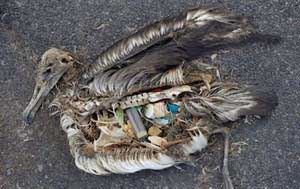Garbage patches
The garbage patches and microplastics threaten the survival of thousands of species. Do you want to know what they are and how do they form?Maybe for a few years now you've heard of the Great Pacific Garbage Patch and the other islands of trash that populate Earth's seas. You've probably seen pictures of an enormous accumulation of debris of all kinds adrift on the ocean surface. This waste stain stretches over a million and a half square kilometers -three times Spain or the sum of Peru and Ecuador-.

However, recent research has somewhat lowered the physical quantity of garbage of these agglomerations although have not diminished the problem of ocean pollution.
What are the garbage patches?
The garbage patches are agglomerations of non-biodegradable waste which by the influence of ocean gyres (the system of rotating ocean currents) are accumulated in large floating rafts. The largest found so far is in the Pacific, but there are four other distributed in the rest of the oceans except the Arctic and Antarctic.
Despite what was always believed since they were first sighted in the late 90s, its size is not as outrageous as initially thought, according to various  agencies and researchers, who however do warn about the serious risk to the marine ecosystems and the lives of thousands of animals. According to the National Oceanic and Atmospheric Administration of the United States, "the term island of trash or garbage patch is not appropriate, as much of the debris found in these areas are small bits of plastic (microplastics) that are suspended throughout the water column."
agencies and researchers, who however do warn about the serious risk to the marine ecosystems and the lives of thousands of animals. According to the National Oceanic and Atmospheric Administration of the United States, "the term island of trash or garbage patch is not appropriate, as much of the debris found in these areas are small bits of plastic (microplastics) that are suspended throughout the water column."
For its part, the Malaspina Expedition, Spanish project with a major international investment to study the state of the oceans, still offers surprising revelations after their 42,000 nautical mile journey between 2010 and 2011. Last year, oceanographer Carlos Duarte, Malaspina leader, flatly denied the existence of the Great Garbage Patch, also known as the garbage plastic island, between the US West Coast and Hawaii as well as the other four, although he clarifies that "the concentration of plastics is 200 grams per square kilometer" something to consider and that needs a solution but "it is certainly not the island that has been so much aired. We expected to find 100 times more plastic than what we've found", Duarte said in an interview with El País newspaper.
The threat of microplastics
Despite the good news that the least amount of floating debris in respect of which was initially thought means, the fact is that the big problem is what underlies the oceans: microplastics. According to the Green Facts initiative, founded by scientists almost fifteen years ago, microplastics are "small particles of plastic that can either be produced as plastic pellets, or result from the degradation of plastic objects such as bags, clothes, household items as well as building materials and fishing and aquaculture gear that has been discarded or lost."

These microplastics represent a direct harm to marine wildlife, as they are easily ingested by fish and birds - and us, as they pass through the food web- causing health problems in their bodies in addition to the known damage caused by larger residues such as ingestion of large pieces, entanglement and drowning or strangulation.
Garbage patches: solutions
Is anybody doing anything to try to prevent the pollution of the oceans? Not enough yet. There are up to ten projects to clean up the trash, control boats and ships waste and scheduled measurement studies will analyze each process. However, the most effective method is to prevent these wastes from entering the sea, and manage them in an effective way can be through reuse and recycling.
Sources: El Mundo, El País, Green Facts and US Department of Commerce.



